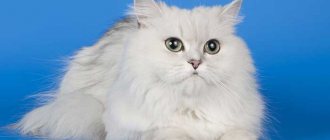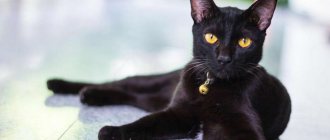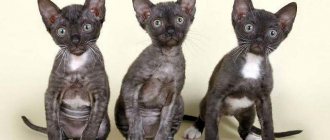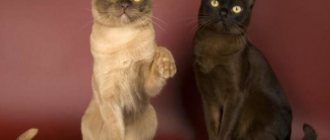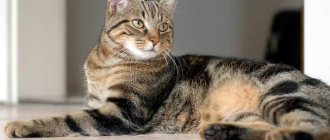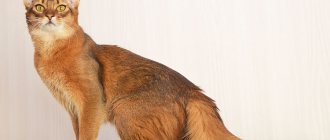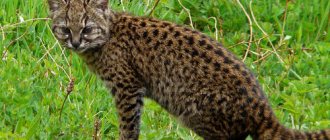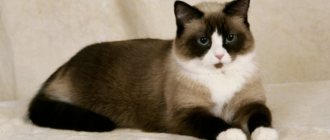A fluffy cat sits with its paws spread out imposingly, the only thing missing is the TV remote control. Straight ears and wide open eyes with a silent question. A Highland Straight representative of one of the four breeds of Scottish cats has settled at home. The pet differs from its relatives in the length and thickness of its fur, and, like a true Straight, is considered to have upright ears. What features do these animals have and how not to make a mistake when choosing a kitten: just find out the requirements of the standard and the recommendations of breeders.
Brief history of the breed
The history of the Scottish Straight cat began in 1961 in Scotland. At that time, the owner of a small farm discovered a fold-eared kitten in the litter of his pet. It was a cat who was named Susie.
She became the progenitor of the fold-eared and straight-eared long-haired Scottish. Breeders infused her descendants with the blood of Persian and British cats. As a result, 2 varieties appeared - Scottish Highland Straight and Scottish Highland Fold. The first has straight ears, and the second has folded ears. The breed was recognized in 1970.
History of the origin of the breed
According to an unofficial version, the “discoverer” of Highland straights was the Scottish farmer William Ross. Quite by chance, he turned out to be the happy owner of long-haired kittens with funny erect straight ears. The unusual offspring was the result of crossing a British cat and a Scottish mother. William decided to give the babies to familiar breeders from London, but his friends were not particularly interested in the new breed, since straight-eared cats were not in demand at that time.
Soon the results of the unusual experiment became known to American breeders. They were the first to start breeding long-haired straight-eared Scots. Breeders were not satisfied with the meager palette of animal colors, as well as some external characteristics. To improve these indicators, they crossed Scots first with long-haired Persians, then with British cats. The unusual breed received official recognition in the second half of the last century.
The name Highland Straight consists of two English words: the first - Highland - comes from the name of the northwestern and northern Scottish highlands, and the second - straight - is translated into Russian as “flat, straight”. Among breeders, representatives of this breed are often called “highland pointy-eared”.
The name of the breed comes from the name of the Scottish Highlands
Long-haired straight-eared cats are still considered a rather rare subspecies of Scottish cats and are not found as often as short-haired Scottish cats. There are very few nurseries in the world that specialize in breeding this breed, so it is extremely rare to see such animals at exhibitions. By purchasing such an exotic pet, the owner becomes the proud owner of an exclusive representative of the Scottish “dynasty”.
Interesting Facts
The long-haired straight-eared cat got its name from the mountainous terrain in Scotland, where the breed originated. The word highland translated from English means “highlands”.
Other interesting facts about Highland Straights:
- These cats have a poorly developed vestibular apparatus. When falling from a height, they do not always land on their feet. Scottish Longhairs are afraid when they are picked up and never climb to heights themselves.
- The Highland Straight gene for long hair was inherited from representatives of the Persian breed.
- Both straight-eared and fold-eared longhaired Scots are used to work with children with special needs. They are present in school classes in some European countries.
Breeding
The Highland Straight can be crossed with a representative of the same breed, as well as with long-haired or short-haired fold-eared cats. In the second case, babies are born with different hair lengths. One litter can have both straight-eared and lop-eared kittens.
Males reach sexual maturity at 10 months of age, so from this time on they can participate in mating at any time. A cat's first heat occurs at 7–8 months, but the body is not yet fully formed in order to bear and give birth to healthy offspring. You can take her to a gentleman only at the age of 1.5 years. Mating usually takes place on the groom's territory. Animals are left alone indoors for 2–3 days, having previously been provided with sufficient food and water.
Important! Before mating, pets must undergo full vaccination and deworming. Feeling unwell may be a good reason to cancel an appointment.
A cat's pregnancy lasts 63–67 days. She becomes calmer and more peaceful. Before giving birth, it begins to look for a nest, so the owner needs to set up a spacious box in advance. Childbirth usually occurs without complications. In order for the cat to recover faster, a complex of vitamins and minerals for nursing animals should be included in the diet.
Highland Straights are caring parents. Not only the cat, but also the cat takes an active part in raising the offspring. If the lives of the babies are threatened, the male can become very aggressive. At this time, the cat is engaged in the socialization of kittens, teaching them the necessary skills (how to wash themselves, use a litter box, hunt, play, etc.).
Breed description, standards, appearance
Scottish Highland Straights are well-built medium-sized cats with a dense build, a large head and a pretty face. Outwardly, they are very similar to their short-haired counterparts.
Dimensions and weight
The Highland Straight's body is proportional, muscular and fit. The height at the withers of an adult cat reaches 30 cm. The average weight of the animal is 4.5-6 kg. Females are slightly smaller than males.
Anatomical characteristics
Description of the Highland Straight breed according to the WCF standard:
- the head is round in shape, with a wide forehead, smoothly turning into the bridge of the nose;
- well-defined cheekbones and whiskers;
- the chin is neat, rounded;
- the eyes are large, round, expressive, the color of the iris depends on the color of the coat;
- Highland Straight ears are small, erect, with a wide base, rounded tips decorated with tassels;
- the nose is straight, without a hump, the nose is small;
- the body is well muscled, but quite flexible;
- The Highland Straight's paws are short, making the cat appear squat;
- the tail is thick, mobile, fluffy, its length reaches the shoulder blades.
Color and coat type
The Highland Straight's coat is long, but shorter than that of the Persian, silky and pleasant to the touch. With good care, it does not get tangled and looks smooth and shiny. In the chest area and on the back of the thighs the hairs are longer.
The standard allows any types of Highland Straight colors:
- solid – white, black, blue, cream;
- bicolor;
- tabby;
- smoky;
- chinchilla;
- shaded;
- tortoiseshell;
- van;
- calico.
Breed standard
The Highland Straight is essentially a straight-eared, long-haired version of the famous Scottish Fold. In terms of body structure, they are practically indistinguishable and belong to the same breed group. Highland Straights are medium to large-sized cats (from 4 to 7 kg) with semi-long hair, massive and muscular.
The standard includes the following provisions:
- Head: Round shape.
- The cheeks are prominent and full. They make the muzzle look thick, while the overall expression of the muzzle is soft, gentle, open and curious.
- The ears are small or medium-sized, wide. They should be placed on the head like “caps”, emphasizing the rounded skull. Under no circumstances should they be placed high or close. The size of the ear is not as important as the set and fit. The tips are rounded.
- The eyes are wide open, large and round, with a sweet, curious expression. Eye color should be in harmony with the coat.
- The chin is moderate.
- The muzzle is moderately wide with softly rounded whisker pads.
- The nose is short and wide.
- The profile shows the soft graceful curve of the nose. Let's allow a sharp transition from the forehead to the nose.
- The neck is short, muscular, and rather thick.
- The torso should not be very long, with soft rounded contours.
- The tufts between the toes, tassels and fur on the ears should be visible.
- heavy eyebrows hanging over the eyes, making the cat’s gaze frown;
- obvious pain, feeling unwell;
Photo gallery: Highland Straight colors
White Highland Straights look like sweet angels
Highland straights of black solid color do not bring bad luck at all
The golden color of the Highlands is the “heritage” of the British breed
The color of the chinchilla is silver with blackened tips of the hairs (tipping)
Chocolate Highland Straights can only have yellow eyes
The name of the color “cinnamon” translates as “cinnamon”
Red, or red, color is one of the brightest
Tortoiseshell color occurs in females in 99% of cases
In Harlequin bicolor colors, spots are randomly scattered across the cat’s body on a white background
Van bicolor color covers only the top of the head and tail, leaving everything else white
Color point colors were inherited from Highland cats from Himalayan cats.
Tabby is a pattern in the form of stripes, spots or marbled “stains” on any color
Tabby colors with white look impressive
Smoky colors are rare among Highlands
Character and temperament
The character of Highland Straights is calm and peaceful, without a hint of aggression. Of all the family members, the cat chooses one person who becomes its object of adoration. She follows him everywhere and unobtrusively begs for a portion of affection. The pet does not like to sit in arms, but does not mind lying in the arms of its owner.
Highland Straights are patient with children and readily play with them. The main thing is that the baby does not offend the cat, otherwise she will avoid communicating with him. Longhaired Scots are not afraid of crowds. When guests arrive, the Highland Straight does not hide, but willingly gets to know everyone present. The only thing that can scare him off is a loud noise.
Highland Straight cats are very smart, so there are usually no problems with litter box and scratching post training. If desired, a long-haired Scottish Fold can be taught to perform simple tricks. Many representatives of this breed can fetch a ball in their teeth and jump over low obstacles on command.
Highland Straights get along well with other cats and dogs, especially if raised with them from an early age. However, the owner should try to pay the same amount of attention to all pets so that they have no reason to be jealous.
Scottish Straight Longhair cats are not very talkative. The pet's voice can be heard in rare cases, for example, when he is hungry. The rest of the time, the Highland Straight is usually silent. Another positive character trait is unobtrusiveness. If the owner is irritated or busy with something, the cat will never get in the way and demand attention.
Varieties of tweed
Despite its uniqueness, there are several varieties of tweed :
- shepherd's check is a fairly dense, coarse fabric of classic colors. This variety came into fashion back in the 19th century and has maintained its brand since then;
- Donegal tweed is generally best suited for waistcoats and jackets. This thin fabric of gray tones is often used to sew suits for every day. In addition, ties are also made from this tweed mixed with silk thread;
- Harris tweed , or English tweed as it is often called, has excellent wear resistance and is available in a wide range of colours. This material is especially good for warm jackets and goes well with jeans or corduroy pants;
- Herringbone is a classic pattern for jackets that is very popular among Americans and continental Europeans. Typical colors are grey, green, brown and even blue. As a rule, this tweed goes well with a classic shirt and trousers;
- Houndstooth is a rather rich pattern that comes in different colors. Houndstooth is not very popular and is considered traditional for coats and jackets;
- Cheviot is a rather coarse and very dense fabric, which owes its name to the Cheviot sheep breed. In the United Kingdom, this type of tweed is used to make tracksuits;
- Covercoat is another variety of tweed typically used for riding jackets and coats. Initially, it was the carpet coat that was widespread in rural Scotland. This fabric is produced in brown and green colors;
- Bedford cord is mainly used for making hunting clothes. This heavy and warm fabric is distinguished from other materials by its wave-like pattern.
How to choose the right kitten
The Highland Straight cat breed is not very common in Russia. And in order not to be deceived, it is better to buy a kitten from a nursery that specializes in breeding Scottish longhair cats. In this case, there is no doubt about the origin of the animal, since the owner of the nursery will provide a pedigree and a veterinary passport.
Kittens must be reserved in advance. The cost of an animal largely depends on the purity of the pedigree and compliance with the standard. Cats suitable for breeding are more expensive.
The average price for a Scottish Highland Straight kitten ranges from 10,000–50,000. Promising individuals without defects in appearance, who have every chance of becoming champions in the future, will cost the new owner 60,000–70,000 rubles.
When purchasing a Highland Straight kitten, you need to make sure that everything is okay with it. A healthy animal has clean ears and eyes, is active, sociable and has a good appetite. You should refrain from purchasing if your cat has dull, greasy fur, rapid breathing, or lethargy.
You should not remove a cat from a cattery before he is 12 weeks old. Until this time, the breeder must take care of him. His responsibilities include vaccination, training animals to use a tray and scratching post, as well as transferring kittens to special food after weaning.
In a litter of Scottish Longhair cats there are both straight-eared and fold-eared kittens. All babies are born with straight ears, which begin to droop at 3-6 weeks of age.
Kitten care
It is important to prepare in advance for the appearance of a Highland Straight in your home and buy everything you need for it:
- tray and filler;
- scratching post;
- bowls for food and water;
- comb;
- shampoo;
- air conditioner;
- products for daily care of ears and eyes;
- toys;
- harness (if you plan to walk).
In the first days of being in the house, the Highland Straight needs extra care. It is important not to frighten the cat, since for her moving to a new place and changing owner is a lot of stress.
The adaptation period for Scottish Longhairs lasts 3-5 days. At this time, you should not force the kitten to play; he needs to get used to the new environment, smells and sounds.
After moving into the house, you need to show the cat where her litter box is. It is better to take some used litter from the breeder in advance. He is placed in the cat's litter box. The pet will smell itself and begin to go to the right place.
Choosing a kitten
Breeders recommend not buying a Highland Straight kitten before 2 months of age. The baby must receive the necessary microelements from mother's milk, get stronger and learn self-care skills. In the nurseries, they vaccinate their children, treat them against fleas, ensure that animals are examined by a veterinarian, and select the best kittens for breeding and participation in exhibitions.
What points should you pay attention to when choosing a kitten:
- wool, it should flow, not hang in clumps like cotton wool;
- position of the ears, the ears of straight cats must stand up and fit tightly to the surface of the skull;
- The tail of a qualified animal cannot be short, with a hook at the tip. It should move well, not cause pain, and be free of thick vertebrae;
- correct number of toes.
Usually the behavior of a kitten is observed: the sick animal is active and playful. A purebred animal is considered as such when a pedigree is provided. In addition, the breeder is required to provide documentary evidence of vaccination and treatment against helminths and fleas. Many owners help with the delivery of their charges to the new owner’s home and provide recommendations and reference materials for caring for their furry pet.
Breeding
Breeding is not so easy: you need to know with whom you can breed a long-haired pet and in what period, so as not to cause painful consequences for the offspring. The Highland Straight is crossed with the Scottish Fold cat; breeding of pets with the presence of the fold gene in both partners is not allowed.
Scottish Straight Scottish Shorthair Straight cat
Scottish fold Scottish fold cat
Care and maintenance
Both a small apartment and a spacious private house are suitable for keeping the Highland Straight breed. Scottish longhair cats are not very active, so they can easily do without walking. Caring for them is not burdensome, but there are still some nuances.
Straight-eared Highland Straights are quite clean. They spend most of their time licking themselves. This is where the main danger lies - the cat swallows the fur, and this can lead to intestinal blockage. For this reason, the pet owner should pay attention to caring for the fluffy coat.
Hygiene procedures
The cat's eyes are wiped every day, otherwise brownish crusts accumulate in the corners. To treat the eyelids, you can use hygienic lotion or warm boiled water and cotton pads.
Caring for your cat also includes cleaning its ears. Although Highland Straights have erect ones, sulfur still accumulates inside. Its excess is removed with a clean sponge soaked in lotion 3 times a month. It is necessary to trim the Highland Straight's claws at approximately the same frequency.
Grooming
Twice a week you need to comb the coat with a massage brush. During molting, the procedure is carried out daily. Highland Straights do not like to bathe, so they are washed no more than 3-4 times a year. This is usually done before visiting the exhibition.
During bathing, use shampoo for long-haired cats and conditioner, which prevents the formation of tangles and adds shine to the fur coat.
Tray
Highland straights are demanding about the cleanliness of the tray. It needs to be cleaned morning and evening. If the litter is dirty, the cat will not want to go inside. Once a week, it is advisable to empty the entire contents of the tray and wash the bottom and walls with hot water, but without using chemicals.
Caring for Highland Straights
Legends can be made about the cleanliness of cats. These long-haired, pointy-eared beauties are also distinguished by their excessive pedantry. They spend hours licking their fur, giving it a well-groomed appearance.
However, Highland Straights cannot cope with so much wool on their own, unlike their Scottish Shorthair counterparts. Hairs can enter the gastrointestinal tract in clumps and lead to intestinal obstruction.
Veterinarians advise brushing this breed's coat daily.
Therefore, veterinarians still recommend daily cat care, which is aimed at combing out the hair. To do this, you can purchase one of these devices:
- a special brush with long metal teeth, rounded at the ends;
- slicker;
- long-toothed mitten;
- furminator (a tool that resembles a small rake);
Furminator for cats with long hair
- crest;
- a double-sided brush (metal teeth on one end, massage bristles made of natural materials on the other).
Attention! An excellent option for combing long-haired cats is to use… your palm soaked in water. Just run it over your pet's fur several times. Dead hairs will remain on the palm.
Cats of this breed (as well as others!) should not be bathed frequently. Once every 4-5 months is enough. To keep your pet's coat silky and smooth, it is recommended to use shampoos specifically designed for medium and long-length coats.
Shampoo for cats with long hair
If the owner wants the animal’s fur to shine and be silky, he should try a little. First, it is recommended to apply degreasing cream to the fur coat and gently rub it in. The product is washed off with warm water. Next, you need to take shampoo and lather it.
Attention! You need to wash off the product thoroughly, otherwise the cat will lick it off, which will cause allergies or stomach and intestinal disorders.
Balms containing nourishing oils will also be useful. They will make the fur coat silkier and will be useful for caring for the coat in winter.
Shampoo for cats with long hair containing oils
The final step in washing is the application of a texturizer - a balm that makes the fur voluminous, prevents the formation of tangles, matting of hairs, and resists electrification.
Spray texturizer
Important! You cannot wash your cat with human balms and shampoos, as this can cause unwanted reactions such as allergies.
You need to dry the fur with a hairdryer. The air should be warm (not hot!), the distance from the animal’s body to the device is 30-40 cm. If the room is warm, you can allow the fur coat to dry naturally.
Important! Highland straights are very clean animals. Therefore, the owner needs to monitor the cleanliness of the tray. Otherwise, the pet may walk past the dirty potty or prefer a more convenient place to relieve its needs.
You can walk with your pets, but only if the cat itself shows interest in this activity. There is no need to buy her an expensive harness and drag her outside if the area outside the house is terrifying to her. Perhaps the cat is a real homebody and a balcony on which birds chirp beautifully is enough for her.
This is how the Highland Straight kitty likes to walk
Otherwise, the care procedures are no different from the others.
- Eye wash. If brown discharge is visible in the corners or the cat’s eyes are constantly watering, then you need to use a sterile cotton swab dipped in regular black tea. Pharmacies sell special products that allow you to treat the organs of vision. You need to wipe from the inside of the eye and aim for the outside.
How to wash a cat's eyes at home if you don't have pharmaceuticals on hand
- The ears are washed with ordinary water, with which the bandage turunda is soaked. The frequency of the procedure is 1-2 times a month. If the owner notices that the pet often shakes its ears and tries to get its paws into it, then cleaning should be done immediately.
A cat's ears can rightly be called its strongest and weakest point. It is well known that a cat's hearing is much more developed than a human's. Thanks to him, cats are able to track mice, even when they make virtually no sound, and escape from predators by recognizing their approach in advance. You can read more about how to clean your cat's ears at home in our separate article.
Feeding the cat
The health and life expectancy of the Highland Straight largely depends on the quality of nutrition. The cat's diet should contain enough vitamins, microelements and protein, which contributes to the formation of muscle mass.
Complete diet
Breeders recommend feeding Highland Straights with ready-made premium or super-premium dry formulas. Industrial feeds are properly balanced and contain meat, grains, vegetables and vitamin supplements. However, some cat owners prefer to create their own diet from natural products.
In this case, you need to include in the Highland Straight menu:
- lean meats - rabbit, turkey, veal, chicken;
- offal – heart, chicken gizzards, liver (once a week);
- sea fish;
- cereals – rice, oatmeal;
- vegetables and herbs;
- low-fat cottage cheese, yogurt, kefir;
- eggs.
The cat should not be fed pork, lard, or potatoes. Salty, spicy foods, sweets, bread and processed foods, as well as bones are strictly prohibited.
Feeding frequency
Adult cats are fed 2 times a day - morning and evening. At lunchtime, you can treat the Highland Straight to a piece of cheese or other delicacy. It is very important that clean drinking water is always available.
Kittens eat more often because their metabolic processes proceed faster. Babies up to 3 months are fed 5-6 times a day. Next, the pets are transferred to a four-time diet. From 6 to 9 months, food is distributed 3 times a day.
Vitamins and minerals
When feeding Highland Straights with natural food, the risk of developing vitamin deficiency increases. After all, it is impossible for a non-specialist to create a diet so that the cat receives all the necessary substances in the right quantity.
For this reason, veterinarians recommend feeding Scottish longhair cats with vitamin and mineral preparations 2 times a year.
Features of the material and production technology
Tweed fabric serves as a standard for consistent quality and excellent work by master weavers . Tweed is a very durable material and almost does not wrinkle due to the special twill weaving of the threads. Now there are many varieties of tweed: in addition to the classic ones, there are quite a few modern versions of the fabric with exotic yarn, original texture and color.
It takes a lot of effort to get tweed. First of all, the sheep need to be shorn, after which the wool goes through several stages of processing - from cleaning to dyeing. Any type of tweed has subtle splashes of color, regardless of the pattern. As a rule, it is red and blue on a beige background or green on brown. There are ancient instructions for mixing colors that weavers always follow. They comb the sheep's wool and carefully mix different colors with fine iron teeth. The threads are woven by hand using special hand looms, and the fabric itself is also made. To make tweed softer, it is soaked in soapy water. This process is called waulking.
Tweed production process (Scottish video)
Education and physical activity
You need to start raising a Highland Straight from an early age. The owner should not allow the cat to cross the established boundaries. When training your pet, you should remember its delicate and sensitive nature.
The Scots are very gentle and vulnerable, you cannot shout at them, and even more so it is forbidden to beat an animal. Rough handling of the Highland Straight will not achieve the desired effect, but rather will lead to a loss of trust on the part of the cat. It is better to be patient and reward your pet for good behavior.
Caring for eyes, ears, teeth and claws
The main problem of Highland Folds is ear care. Since they are wrapped and pressed tightly to the head, cats cannot do it on their own. They definitely need help with this. They should be cleaned once a week using a cotton swab or rolled-up cotton pad. To make it easier, you can purchase ear drops at a specialized store. They will soften accumulated plaque and dirt.
Important! You can’t insert the stick too deeply; just gently move it along the edge of the ear.
Representatives of the Highland Fold breed have a tendency to cry frequently. You need to keep an eye on this and regularly wipe their eyes with a soft cloth. The main thing is that there are no lint or other small components on it that can enhance the effect.
In order to eliminate plaque on the teeth, it is necessary to introduce dry food into the animal’s diet. If the owners have relied on natural nutrition, then chewing large pieces of meat will help cope with this problem.
Pet stores offer a wide variety of special sticks, toys, and you can also buy toothpaste for cats, which you should use to brush your cat’s teeth once a week.
Like all cats, Highland Folds love to sharpen their claws. To avoid damaged furniture, clothes and carpets, you need to purchase special scratching posts. But it happens that even after its appearance in the house, the claws remain long and sharp. This can have a negative impact on the animal itself and those around it. There is a nail clipper especially for such cases. It is useful for every cat breeder to have.
Advice! If an owner is wary of trimming a cat's nails themselves, this service is available at most veterinary clinics.
Highland fold kitten with scratching post
Health and susceptibility to disease
In general, the Scottish Highland Straight cat is in good health. However, this breed is prone to diseases of the musculoskeletal system. The most common are hip dysplasia and osteochondrodysplasia.
These diseases are manifested by deformation of bones and cartilage tissue. Highland straights are also susceptible to skin diseases - allergies, dermatitis. Healthy cats with good care can live about 18 years.
Health
Scottish Highland cats have good health. They are hardy. To date, no genetic diseases have been identified in straight cats. Sometimes they may experience problems with the spine and joints as they age, due to a reluctance to move.
Highland Straight breeders recommend keeping them out of direct sunlight.
Attention! To maintain the proper microclimate in the room where the cat lives, it is necessary to install an air humidifier.
If you feed your cat correctly and follow all grooming procedures, then its lifespan can be increased to 20 years, with an average lifespan of 12-15 years.
Well-groomed Highland Straight kitten
Vaccinations and antiparasitic treatment
Not a single domestic cat is immune from infection with infectious diseases, and the Highland Straight is no exception. Some of them can be deadly, including:
- chlamydia;
- calcivirosis;
- rabies;
- panleukopenia, or plague.
Cats are vaccinated against these diseases when they reach three months of age. At this time, the kittens are still in the nursery, so vaccination is carried out by the breeder. Next, you need to vaccinate Highland Straights annually.
Twice a year it is recommended to carry out preventive treatment of the animal against fleas and worms.
Purchasing a Highland Fold kitten
Highland Fold cats are quite rare, but nevertheless many breeders love them, and children simply dream of owning such a cute, unusual cat. Kittens' ears are initially erect; they bend 3 weeks after birth. And at 3 months, babies can already be put up for sale, since it is at this time that folds can be distinguished from straights, the difference between them becomes obvious.
How to choose a kitten
Before purchasing a kitten, it is worth visiting a nursery and observing it in its natural environment. This will help you choose a pet with the desired character, as well as monitor the animal’s physical condition and health.
Offspring of Highland Folds
A healthy kitten has fluffy, soft fur, no bald spots, and clean eyes. The cat himself is sociable, active, playful, and friendly. If all these signs are present, then the little Highland Fold is healthy and without congenital pathologies.
Important! Particular attention should be paid to the tail of the animal. It should not be short, and should be actively moving and flexible. Such a check must be carried out, since congenital joint disease is often transmitted along with the lop ear gene.
How much does it cost and where to buy
The cost of the baby depends on the place where it is purchased. A purebred kitten, purchased from a trusted cattery, with a good pedigree and a complete package of documents, can cost up to $1000. However, if there is no pedigree, a cat can be purchased for less than $100.
Highland Folds are sold in nurseries. There are enough of them in Russia, among them you can choose the one closest to your home and with the best reputation. Kittens without a pedigree are also sold on well-known websites specializing in the sale of various products.
Important! When purchasing a pet without a pedigree, you should be careful, since it is possible to purchase a representative of a completely different breed, with different characteristics.
Pros and cons of the breed
The Scottish Longhair Highland Straight cat deserves the attention of potential owners, because it has many more advantages than disadvantages:
| pros | Minuses |
| Beautiful appearance | Long wool |
| High intelligence, good learning ability | Tendency to joint and bone diseases |
| Friendly, calm character | Great cost |
| Cleanliness | |
| Tolerance for children | |
| Ability to get along with other animals |
Highland Straight cats are ideal for families with children and older people. They are not too active, obedient, smart and clean, so they do not create many problems for their owners.
Such a pet will be able to brighten up the life of a lonely person and join a large family, becoming a true friend for a child. However, those who are forced to often leave home should not get a Highland Straight. After all, representatives of this breed become very attached to their owner and constantly need his attention.
Breed defects
Since the breed is quite young and not numerous, its gene pool is limited, and if the rules of breeding are violated, both hereditary health problems and some phenotypic deviations from the standard can arise.
Tendency to diseases
Straight-eared Scottish cats are distinguished by enviable health and, if kept in good conditions, live up to twenty years without problems. The main problems can be various anomalies of bones and joints, caused by both poor heredity and improper cultivation.
The basis of most of these ailments is often a genetic pathology, fixed in the process of illiterate or unscrupulous breeding work. Unfortunately, such diseases can rarely be completely cured. However, the sooner they are diagnosed, the higher the likelihood of maintaining the animal in normal physical shape.
A common breed problem is poor mobility of the spinal joints. Show experts pay special attention to the cat's topline when moving: it should be level and stable. A cat can be removed from the show if its joints crack or squeak - this is considered a disqualifying fault, indicating poor genetics - such animals should not be bred.
Among the breed diseases of Straights there is even dysplasia of the hip and elbow joints - a pathology that is generally extremely rare in cats. A reliable diagnosis of the disease is provided by correctly taken x-rays of an animal that has reached one year of age. The veterinarian will prescribe treatment or supportive care depending on the degree of dysplasia. In some difficult cases, surgical intervention is indicated.
The consequence of an unbalanced, too abundant and high-calorie diet is obesity characteristic of the breed and associated diseases of the cardiovascular system.
Flaws in appearance
The breed standard pays special attention to the Straight's ears - they should not be large or even slightly sagging. Such shortcomings automatically prevent the animal from participating in the exhibition, and therefore in breeding. A serious drawback is considered to be “wadding”, matting and tangling hair, as well as long tufts of it on the eyebrows or other parts of the head. Cats with any abnormalities in the structure of the bones or joints will not receive high expert ratings; weighted animals.
Disqualifying faults include a tail that is too short and stiff, a hook at its tip, and an unusual number of toes on the paws. The animal must be healthy and move easily and harmoniously.
Video: Highland Straight kitten at an exhibition
Adaptation of a kitten in a new home
For a small 3-month-old kitten, a new home is someone else's home. Therefore, when purchasing, be sure to consult with the breeder about the baby’s preferences. In the apartment where he will live, you need to have a minimum set of necessary items.
First, you should show him the kitchen, the toilet, the corridor, and only then let him into the rest of the rooms. This can be done only after the baby understands where the toilet is. Otherwise, problems may arise with this.
A handsome fluffy dog with folded ears and fur that is smooth and thick, like a chinchilla’s, this is a Highland Fold. His cuteness makes you fall in love at first sight. An easy-going character, friendliness and affection are what families with children need. Animals of this breed will delight their owner from the very first day for many years.
From the history
A plaid is essentially a kilt (Scottish national men's clothing). The modern kilt bears little resemblance to a plaid, while the traditional one essentially was one. The kilt was a woolen cloth up to 8 meters long and about one and a half meters wide. Male warriors wrapped this cloth several times around their waist, throwing it over their shoulder so that, if necessary, they could cover their head.
Scotland is a northern country with a harsh climate, frequent rainfall and mountainous terrain. A kilt, if you think about it, is the ideal clothing for warriors in such conditions - warm, light, does not restrict movement, dries quickly and does not rub anywhere. Therefore, the kilt was originally a military uniform, striking in its versatility. During the day it was clothing and at night it was a blanket.
During the battles themselves, Scottish warriors took off their kilts (and it is especially important that this could be done quickly) and fought without clothes.
A distinctive feature is the “checkered” pattern.
Here, too, not everything is so simple: the check (in our country it was called “tartan”, the traditional name is tartan) was a kind of distinctive sign. The Scots respect the national pattern, cherish it and strictly take into account all its varieties. Currently, there are about 6 thousand species in the national tartan register. Each clan has its own tartan.
Colors were also of great importance - the colors of woolen clothing determined whether a warrior belonged to a particular army, and subsequently the number of colors determined a person’s class:
- only the king had the right to wear clothes made of seven-color tartan,
- out of five - the head of the clan,
- of the three - a warrior,
- of the two are farmers,
- and servants could only wear clothes of the same color.
To this day, the colors of Scottish wool blankets are named after their clan - the colors of the Clan Bruce, the tartan of the Clan MacLeod.
Characteristics of Scottish Fold cats
The appearance of a Scottish Fold cat with long hair fully reflects his temperament. Peacefulness, calmness, good nature, devotion, sociability - these are the main characteristics of this cute four-legged friend.
When a Highland Fold cat appears in your home, it brings with it comfort, affection and tenderness. The pet is very respectful of its owner. Since these cats prefer communication with people to loneliness, they are often nearby. But at the same time, the long-haired beauties never impose themselves and are sensitive to the mood of family members.
They love to play with children, but never show signs of aggression. Both young kittens and older cats enjoy participating in outdoor games. This combination of playfulness and some phlegmatism seems surprising. But Highland Folds are all the more admired and attracted to them.
Peace-loving creatures also easily get along with other animals in the house. They are valued for their combination of high intelligence and cleanliness. Cats of this breed easily learn to go to the litter box and never damage furniture or other items in the house.
The animal’s stable psyche allows it to withstand possible trips and relocations well. Highland Folds rarely become stressed or depressed. The temporary absence of the owner does not negatively affect their psychological and physical condition.
Character
The Highland's temperament is reminiscent of water: it accepts the conditions of any vessel into which it falls. Simply put, if peace and tranquility reigns in your home, then a cat will certainly become the embodiment of this peace. This is a calm and meek creature, practically incapable of mischief. The only thing that is required from the owner to maintain this harmony is to live by the cat’s rules.
Having been a predator in the past, the Highlands cannot help but dictate terms. And the owners, being captivated by the beauty of the cat, cannot help but obey her command. This is how the strongest “cat-human” union is achieved.
In everyday life, the Highland is calm and self-confident. He is completely satisfied with the owner's bed as a sleeping place and the most delicious food as lunch. All this is provided to the cat without further ado, so peace always reigns in the family. The cat is happy - we sleep peacefully.
If the usual “weather” in the house fails, manifesting itself, for example, in a tasteless breakfast, the cat will prefer to wait out this bad weather, remaining hungry. He will not demand better food, and especially will not intrude with questions. Meowing while begging for food is bad manners.
Highland cats are characterized by English temperament. The pet will not beg not only for food, but also for attention. He will always wait until he is called, and will never sit too long in your arms.
Idleness is the lot of the less aristocratic assholes, but the Scotsman always has things to do. It is necessary to check the territory and observe the household members.
The only thing that can shake up the calmness and peacefulness of a Scottish cat is injustice. He is ready to fight with her claws and teeth. Try not to offend your Highland, because his revenge will be so exquisite and unforgettable that you will not immediately remember why you decided to take revenge.
This cat remembers insults all her life. Once you throw her out of the kitchen, you will forever tarnish your reputation in green eyes, which you will have to make up for with kilograms of goodies.
